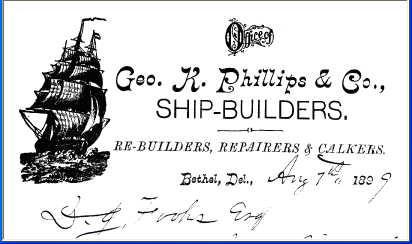Collecting Delaware Books
Sussex County Shipbuilding

Delaware has long been known as a shipbuilding state. Access to the Delaware River and Bay make it a natural location. David B. Tyler's 1958 book on shipbuilding near Wilmington from 1840 to World War I is titled The American Clyde in reference to the shipbuilders' river in Scotland.
Southern Delaware also had a thriving shipbuilding industry in the days of wooden ships. Proximity to oak and pine was a major factor. It is also believed that low wages accepted by local workers made the business profitable long after labor-intensive wooden hull construction became impractical elsewhere. A fascinating record of one shipbuilding center is Sailing Rams A History of Sailing Ships Built In and Near Sussex County Delaware by James E. Marvil, M.D., published in 1961 in Laurel.
Marvil is the grandson of J.M.C. Moore, designer and builder of schooners bearing the nickname "ram." The origin of the name is unknown. Many of these vessels were built between 1880 and 1910 for Chesapeake Bay commerce. They had flat bottoms and a shallow draft for passage through the Chesapeake and Delaware Canal. There were no square-rigged topsails and the jib rigging was simplified. This allowed a substantially smaller crew.
Rams were not built on the Delaware Bay. Instead, they were constructed at Bethel, near Laurel, and at Sharptown, Maryland. From the shipyards, the only access to open water was down Broad Creek and the Nanticoke River through Maryland to the Chesapeake Bay. The river was so narrow at the shipyard that new hulls, some as long as 110 feet, had to be launched sideways.
The 255-page book includes much detail about specific vessels, shipbuilders, shipbuilding methods, ship owners, captains, and typical voyages. The whereabouts of surviving rams is traced. The book has information on other ships and barges built in the area and 117 pictures, one in full color.
Sailing Rams is nicely printed and bound in an 8- by 11-inch format. It is not typeset the text is printed by offset from typewriter copy. A picture of a ram is stamped in gold on the cloth-covered boards. Fine copies with a dust jacket usually sell for well under $100.
Marvil also wrote Pilots of the Bay and River Delaware and Lewes Lore, 1965, and A Pictorial History of Lewes, Delaware, 1605-1985, Lewes 1985.
Letter to the Editor, Feb. 1994
Dear Mr. Reid,
The article on Sussex County shipbuilding in the last issue brings to mind the book Mispillion-Built Sailing Vessels 1761-1917 by Betty Harrington Macdonald, published by the Milford Historical Society in 1990. This is very interesting, and Betty worked on it for some time and contacted many descendants of those named in the book as owners or builders. Unfortunately, my copy, I see, is coming loose page by page, being a paperback of heavy, shiny paper. — Gertrude Draper
Thanks for telling me about this. I was unaware of the book. It sounds fascinating, and I will look for a copy. Macdonald, of course, wrote and made drawings for the News Journal in a column about historic buildings of Delaware and the Eastern Shore. These were collected in a book that was printed in many editions. Pages coming loose are typical of certain glued bindings. The only cure is to reglue with a flexible glue. An experienced bookbinder would have both the right materials and the knack. — JPR